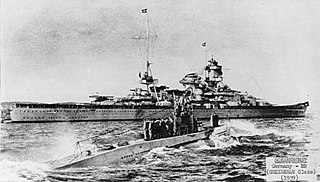
German submarine U-47 was a Type VIIB U-boat of Nazi Germany's Kriegsmarine during World War II. She was laid down on 25 February 1937 at Friedrich Krupp Germaniawerft in Kiel as yard number 582 and went into service on 17 December 1938 under the command of Günther Prien.
German submarine U-262 was a Type VIIC U-boat of Nazi Germany's Kriegsmarine during World War II.
German submarine U-333 was a Type VIIC U-boat of Nazi Germany's Kriegsmarine during World War II. The submarine was laid down on 11 March 1940 at the Nordseewerke yard at Emden, launched on 14 June 1941, and commissioned on 25 August 1941 under the command of Kapitänleutnant Peter-Erich Cremer. After training with the 5th U-boat Flotilla at Kiel, on 1 January 1942 U-333 was transferred to the 3rd U-boat Flotilla based at La Pallice for front-line service.

German submarine U-502 was a Type IXC U-boat of Nazi Germany's Kriegsmarine during World War II. The submarine was laid down on 2 April 1940 at the Deutsche Werft yard in Hamburg with yard number 292, launched on 18 February 1941 and commissioned on 31 May under the command of Kapitänleutnant Jürgen von Rosenstiel.
German submarine U-31 was a Type VIIA U-boat of Nazi Germany's Kriegsmarine during World War II. She was laid down on 1 March 1936 as yard number 912, launched on 25 September and commissioned on 28 December 1936.
Endrass was a "wolfpack" of German U-boats that operated from 12 to 17 June 1942 in attacking Convoy HG 84 that comprised 23 Allied ships. The group's name commemorated the U-boat commander Engelbert Endrass, who was killed in action in December 1941.
Blücher was a wolfpack of German U-boats that operated during the World War II Battle of the Atlantic from 14 to 28 August 1942. They attacked the Freetown, Sierra Leone to Liverpool convoys SL-118 and SL-119, and sank six ships for a total of 41,984 gross register tons (GRT), and damaged one (10,552 GRT). The group was named after Gebhard Leberecht von Blücher (1742–1819), a Prussian Generalfeldmarschall in the Napoleonic Wars.
German submarine U-438 was a Type VIIC U-boat of Nazi Germany's Kriegsmarine during World War II.
Hecht was the name of two "wolfpacks" of German U-boats that operated during World War II.
Hai was a wolfpack of German U-boats that operated from 3 to 21 July 1942 in the Battle of the Atlantic during World War II. They attacked the Liverpool to Freetown, Sierra Leone convoy OS-33, sinking eight ships for a total of 61,125 gross register tons (GRT).
Vorwärts was a wolfpack of German U-boats that operated from 25 August to 26 September 1942, in the Battle of the Atlantic during World War II. They attacked several convoys, principally Convoy ON 127, sailing from Liverpool to New York, and sank fifteen ships for a total of 79,331 gross register tons (GRT), and damaged nine (81,141 GRT).
German submarine U-557 was a Type VIIC U-boat built for Nazi Germany's Kriegsmarine for service during World War II. She was laid down on 6 January 1940, launched on 22 December 1940 and commissioned on 13 February 1941. Oberleutnant zur See Ottokar Arnold Paulssen was in command throughout her career. For her first three war patrols her 2nd Watch Officer was Herbert Werner, who later wrote the memoir of U-boat service, Iron Coffins. She sank six merchant ships and one warship, a total of 31,729 gross register tons (GRT) and 5,220 tons over four patrols.
German submarine U-338 was a Type VIIC U-boat of Nazi Germany's Kriegsmarine during World War II. The submarine was laid down on 4 April 1941 at the Nordseewerke yard at Emden, launched on 20 April 1942, and commissioned on 25 June 1942 under the command of Oberleutnant zur See Manfred Kinzel.

German submarine U-558 was a Type VIIC U-boat in the service of Nazi Germany's Kriegsmarine during World War II. She sank 18 ships totalling 94,099 GRT before being sunk by bombers on 20 July 1943.
Belgian Airman was a 6,959-ton cargo ship which was built by Harland & Wolff Ltd, Glasgow in 1941 for the Ministry of War Transport (MoWT). She was launched as Empire Ballantyne and transferred to the Belgian Government in 1942. She was sunk by a German U-boat on 14 April 1945.
German submarine U-753 was a Type VIIC U-boat built for Nazi Germany's Kriegsmarine for service during World War II. Commissioned on 18 June 1941, she served with 3rd U-boat Flotilla until 30 November as a training boat, and as a front boat until 13 May 1943 under the command of Fregattenkapitän Alfred Manhardt von Mannstein.

The German submarine U-109 was a Type IXB U-boat of Nazi Germany's Kriegsmarine that operated during World War II. She conducted nine war-patrols, sinking 12 ships and damaging one. All but one of these were during the six patrols she carried out under the command of Heinrich Bleichrodt.

German submarine U-105 was a Type IXB U-boat of Nazi Germany's Kriegsmarine. She was ordered on 24 May 1938 as part of Germany's naval rearmament program. Her keel was laid down in Bremen on 16 November 1938. After roughly seven months of construction, she was launched on 15 June 1940 and formally commissioned into the Kriegsmarine on 10 September 1940.
German submarine U-568 was a Type VIIC U-boat built for Nazi Germany's Kriegsmarine for service during World War II. She conducted five patrols, sinking one merchant ship, two warships, and severely damaging another warship. On 28 May 1942, she was depth charged and sunk in the Mediterranean Sea; all hands survived.
Prien's wolfpack is the name given in some sources to a formation of German U-boats that operated during the Battle of the Atlantic in World War II. It existed from 12 June to 17 June 1940.




